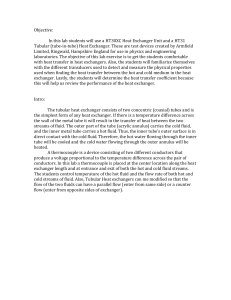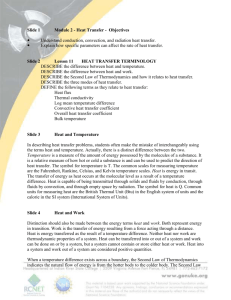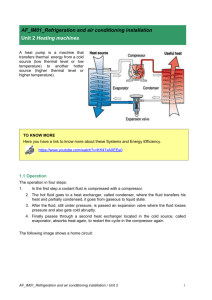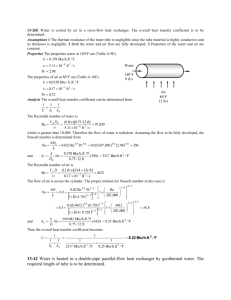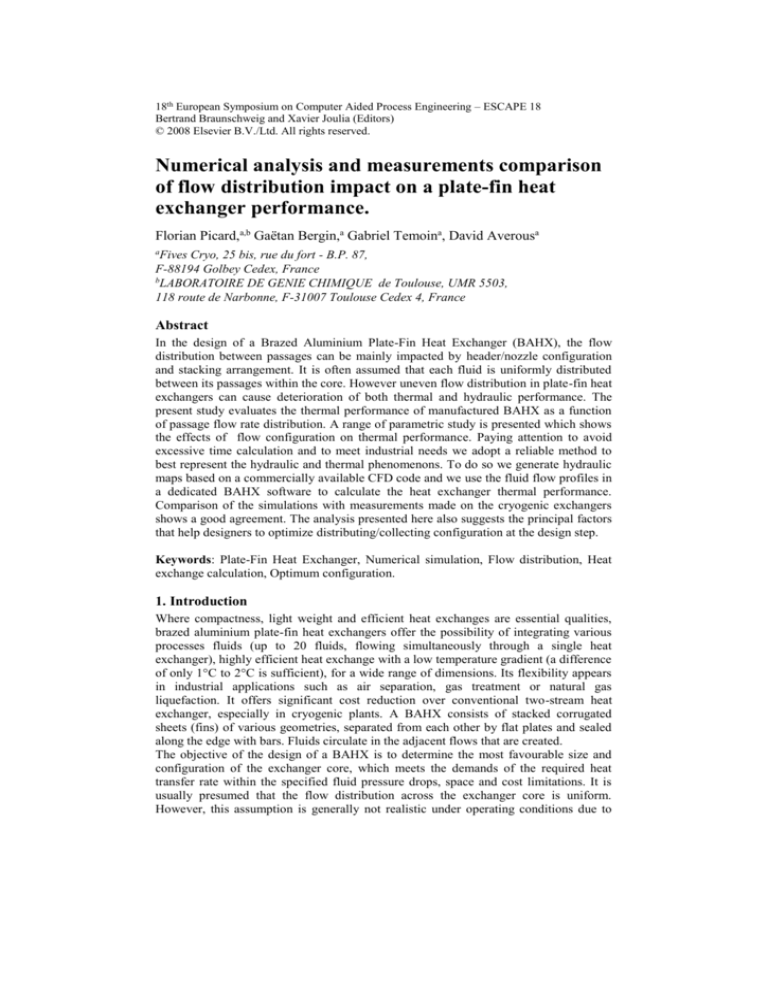
18th European Symposium on Computer Aided Process Engineering – ESCAPE 18
Bertrand Braunschweig and Xavier Joulia (Editors)
© 2008 Elsevier B.V./Ltd. All rights reserved.
Numerical analysis and measurements comparison
of flow distribution impact on a plate-fin heat
exchanger performance.
Florian Picard,a,b Gaëtan Bergin,a Gabriel Temoina, David Averousa
a
Fives Cryo, 25 bis, rue du fort - B.P. 87,
F-88194 Golbey Cedex, France
b
LABORATOIRE DE GENIE CHIMIQUE de Toulouse, UMR 5503,
118 route de Narbonne, F-31007 Toulouse Cedex 4, France
Abstract
In the design of a Brazed Aluminium Plate-Fin Heat Exchanger (BAHX), the flow
distribution between passages can be mainly impacted by header/nozzle configuration
and stacking arrangement. It is often assumed that each fluid is uniformly distributed
between its passages within the core. However uneven flow distribution in plate-fin heat
exchangers can cause deterioration of both thermal and hydraulic performance. The
present study evaluates the thermal performance of manufactured BAHX as a function
of passage flow rate distribution. A range of parametric study is presented which shows
the effects of flow configuration on thermal performance. Paying attention to avoid
excessive time calculation and to meet industrial needs we adopt a reliable method to
best represent the hydraulic and thermal phenomenons. To do so we generate hydraulic
maps based on a commercially available CFD code and we use the fluid flow profiles in
a dedicated BAHX software to calculate the heat exchanger thermal performance.
Comparison of the simulations with measurements made on the cryogenic exchangers
shows a good agreement. The analysis presented here also suggests the principal factors
that help designers to optimize distributing/collecting configuration at the design step.
Keywords: Plate-Fin Heat Exchanger, Numerical simulation, Flow distribution, Heat
exchange calculation, Optimum configuration.
1. Introduction
Where compactness, light weight and efficient heat exchanges are essential qualities,
brazed aluminium plate-fin heat exchangers offer the possibility of integrating various
processes fluids (up to 20 fluids, flowing simultaneously through a single heat
exchanger), highly efficient heat exchange with a low temperature gradient (a difference
of only 1°C to 2°C is sufficient), for a wide range of dimensions. Its flexibility appears
in industrial applications such as air separation, gas treatment or natural gas
liquefaction. It offers significant cost reduction over conventional two-stream heat
exchanger, especially in cryogenic plants. A BAHX consists of stacked corrugated
sheets (fins) of various geometries, separated from each other by flat plates and sealed
along the edge with bars. Fluids circulate in the adjacent flows that are created.
The objective of the design of a BAHX is to determine the most favourable size and
configuration of the exchanger core, which meets the demands of the required heat
transfer rate within the specified fluid pressure drops, space and cost limitations. It is
usually presumed that the flow distribution across the exchanger core is uniform.
However, this assumption is generally not realistic under operating conditions due to
2
F.Picard et al.
flow non-uniformity induced for one part by distributing and collecting means which
leads to passage-to-passage maldistribution. Maldistribution can also be caused by the
distributor interior configurations that affect the flow repartition inside a given passage,
two-phase flow which can be difficult to distribute uniformly and fouling or plugging.
However none of the last cited possible causes of fluid maldistribution will be
investigated in the present study.
The objective of this work is to investigate the effects of different distributing/collecting
configurations on the fluid flow distribution in a plate-fin heat exchanger and optimise
the design of the configuration, regarding thermal performance.
2. Calculation procedures
A computational fluid dynamics (CFD) program FLUENT has been used to predict the
3 D fluid flow distribution of monophasic fluids on the cold and warm sides in BAHX.
Indeed the design of the headers/ducts affects the velocity distribution approaching the
face of the exchanger core. Using these fluid flow distributions, the exchanger
effectiveness and its deterioration due to flow non-uniformity are calculated at the same
operating conditions by means of a dedicated BAHX software, PROSEC.
Physical
properties
Passage pressure drop
FLUENT
PROSEC
Flow distribution
BAHX
configuration
fig. 1. Lay-out of the calculation structure.
In FLUENT, the conservation equations of mass, momentum are solved using the finite
volume method. The turbulence flow was calculated by the SIMPLE method, and a
second order upwind differential scheme was applied for the approximation of the
convective terms. The finest implemented mesh involved about 600,000 cells.
Composite constructive grids are used in the computation.
A standard k– model was used to predict turbulent flow. There are some assumptions
in the CFD simulation : the flow is stable, the fluid flow meets the Boussinesq
assumption and the fluid is considered as an incompressible Newtonian fluid.
It is assumed that the inlet tube is long enough to allow the establishment of the velocity
profile before its junction with the header. We take also for granted that the passages for
each fluid have the same size and shape and have the same kind of fins resulting in a
comparable flow resistance (associated with reasonable manufacturing tolerances).
Boundary conditions and convergent conditions are as follows : inlet fluid velocity and
pressure at outlet vent are specified. Adiabatic wall condition is applied and no slip
occurs at the wall. Convergent condition is specified to absolute residuals <10 -5. The
evolution of fluid properties at the inlet and the outlet of the exchanger is incorporated.
The local flow non-uniformity parameter i is defined as
Numerical analysis and measurements comparison of flow distribution impact on a
plate-fin heat exchanger performance
3
i
passagei mass flowrate
mean mass flow rate
where the mean mass flow rate is calculated as total mass flow rate divided by the
number of passages. The representation of this non-dimensional flow non-uniformity
parameter i is useful for relative comparison between the various configurations.
This work considers the change of heat-transfer coefficient in each passage due to the
uneven distributed flow rates amongst themselves. A given BAHX is thermally
described taking the distribution obtained by CFD simulation. The software used,
PROSEC, is completely adapted for the thermal modelling of the full complexity of
multi-fluids plate fin heat exchangers. According to the width, length of the sheets, the
type of fin (straight, perforated, serrated, etc.), the number of stacked sheets, the fluid
fitting sequence between flows, various configurations can be simulated. The flow
maldistribution can be incorporated as an input parameter. It is assumed that a twostream counterflow exists in the heat exchange, in which the distribution in each side is
well known. The longitudinal wall heat conduction was taken into account in our
calculations. The pressure drop evolution in the layers is based on a simulation with this
software, in which the uniform distribution assumption is implemented. This
characteristic is used to reproduct correctly the evolution of this physical parameter in
the CFD simulation.
The overall heat-transfer coefficient UA (W/°C) was evaluated for each configuration.
The exchanger thermal performance deterioration factor is introduced to illustrate the
impact of the flow non-uniformity on the deterioration of thermal performance. It is
defined as
Γ
UAnon-uniform
UAuniform
The thermal performance deterioration factor
deterioration of the exchanger effectiveness.
directly shows the degree of
3. Overview of the studied configurations
In a conventional design of BAHX the inlet and outlet ducts are connected to the center
of their respective headers. In this work, the heat exchanger is composed of one core
only and works in the counterflow way. Due to on-site space constraints the nozzles can
be moved at the inlet and the outlet from the centers of their respective headers. This
modification leads to a modified flow distribution that is often neglected. Indeed header
tanks used in BAHX have inevitably large cross-sectional area compared with the
finned heat transfer passages. It is then frequently assumed that the headers
configurations do not contribute significantly to maldistribution and pressure drop. That
is why we mainly studied the deterioration of BAHX performance due to flow nonuniformity of principally one of the fluid for which the distributing/collecting system
deviates from usual practices. We emphasize on the influence of some of the
characteristics of the distributing/collecting device, especially the location of the
nozzles, their number and the diameter of the headers.
At first the thermal performance variation have been calculated when ducts are placed at
the centre of the header and in front of the core for all the fluids that are circulating in
the BAHX. Afterwards we investigate a close configuration when ducts of one of the
4
F.Picard et al.
process streams are moved from this central position. Then we simulated the influence
of the size of the outlet header in this last configuration and the addition of two more
nozzles.
fig.2. Representation of one of the studied BAHX (cold side).
The detailed configuration of plate-fin heat exchanger associated with
its
headers/nozzles for the cold fluid is shown in Fig. 2. The principal characteristics of the
different components of the BAHX are reported in table 1.
Table1. Main characteristics of studied BAHX
Stream
Cold Warm 1 Warm 2
Number of layers
80
40
40
125
150
100
Outlet 150
100
100
150
80
80
80
Header Inlet
Inlet diameter
(mm)
Nozzle Inlet
100
Outlet 150
4. Results
4.1. The evaluation of flow maldistribution influence
In a preliminary approach, we studied the hypothetical case when we let the mass flow
rate equally distributed to all the passages of all the fluids. As a consequence, the heat
transfer coefficient in each passage depends only of the stacking arrangement. This
leads to the calculation of UAuniform and facilitates a comparison of the different
configurations through the factor previously defined.
The influence of the conventional maldistribution of the fluids altogether when all the
nozzles are centered with their corresponding header is then observed. Because the
headers have larger dimensions comparing to the duct diameters, the fluid tends to go
preferentially into the passages in the center (Fig. 3) inducing higher velocities in the
central passages straightly facing the centered nozzles.
Numerical analysis and measurements comparison of flow distribution impact on a
plate-fin heat exchanger performance
5
1.40
Hot 1
Hot 2
Cold fluid
1.30
1.20
1.10
1.00
0.90
0.80
0.70
0.60
0
0.1
0.2
0.3
0.4
0.5
0.6
0.7
0.8
header axial position (m)
fig.3. Flows distributions for the hot and cold fluids in the conventional ditributing/collecting configuration.
The velocities in the two bottoms of the header are also lower because the fluid has been
distributed into the passages before it reaches its ends. These results were clearly
expected. In the meantime this particular configuration shows that the deterioration of
the thermal performance is almost insensitive ( = 0.98) and is acceptable with regard
to safety factor range. With no corrective action the exchanger could work under
acceptable conditions. It is because the large hot flux of centre part exchanges heat with
the large cold flux and the small hot flux of peripheral section exchanges heat with the
small cold flux. In one word the duties beween the cold streams and the warm streams is
homogeneously distributed all along the core.
For industrial purposes the effects of the increase of the outlet header size (nominal
value : inner diameter 150 mm) on flow non-uniformity are illustrated in Fig. 4 when
the nozzles are shifted from the centre of the cold fluid at the inlet and at the outlet (see
fig. 2). The dispersion of the results reflects the flow distribution evolution which is
severe in the nominal case and tends to stabilize as outlet header diameter increases.
The fluid flow maldistribution is very serious in the axial direction of headers, so the
improvement of the header configuration has become more and more exigent. The
dissymmetry of the flow distribution in the transverse direction with respect to the
nozzle axis is obvious.
But the most important factor is the thermal performance of the heat exchanger. Table 2
illustrates the important degradation of thermal performance for the smaller outlet
header size and an outstanding improvement as outlet header size augments. The local
flow resistance along the axial direction of the outlet header contributes to settle an
heterogeneous flow distribution inside the heat exchanger.
Table2. Evaluation of BAHX performance for different configurations.
Outlet header ID (mm)
150
0.51
200
0.92
300
0.99
400
0.99
6
F.Picard et al.
1.20
ID150
ID200
ID300
ID400
1.15
1.10
1.05
1.00
0.95
0.90
0.85
0.80
0
10
20
30
40
50
60
70
80
passage number
fig.4. Evolution of the cold fluid distribution profile of different outlet header sizes.
It is found that the effect of the proposed outlet header configurations on the velocities
distribution inside the passages is remarkable. It has to be noted that the coupled
CFD/thermal software prediction is in good agreement with experimental data obtained
for an outlet header ID of 150 mm.
A critical point is the dissymetry of the maldistribution. Indeed in fig.2 the thermal
performance degradation is almost insensitive in spite of the distribution inside the
passages is not uniform along the heat exchanger. The main difference observed in fig.
4, keeping the same outlet header size for the cold fluid, is that the layers located up
receive larger fluid quantities than that situated down leading to a heterogeneous
distribution of the cold streams with respect to the warm side . Another crucial point is
the dispersion of i from the average value. The less the distribution is dispersed the
better is the heat exchanger thermal performance. The aim is to obtain an uniform
repartition of the fluxes inside the exchanger even when the distributing/collecting
configuration is distorted.
For cost reason and design restriction the simulated solution of using a large outlet
header size on the cold size is not possible. We have to consider another way to provide
an optimised design that reach all the industrial specifications. As we have just seen one
of the critical issue is the achievement of an homogeneous repartition of the flow among
the different passages where the cold fluid is flowing.
4.2. Analysis and optimisation of distributing/collecting configuration
A significant point is the relative proportion of pressure drop in each section of the heat
exchanger. The more pressure loss is effective in the exchange the less sensitive to
header/nozzle configuration the heat exchanger is. It is also observed that when the
same flow maldistribution occurs on each fluid side (hot and cold), the deterioration of
the exchanger performance is lower than that when only one fluid flow is disturbed.
Again the explanation is that the larger hot fluxes at the top of the exchanger exchange
heat with the larger cold fluxes and similarly at the bottom between the lower fluxes.
Numerical analysis and measurements comparison of flow distribution impact on a
plate-fin heat exchanger performance
7
fig.5. Streamlines in the BAHX with a modified configuration.
The worst configuration is observed when the flow maldistribution is unsymmetrical
along the axis of the headers for one fluid. For economical reasons, it is desirable to
choose a simple way to homogenize the fluid flow. To modify the velocity in the outlet
header without modifying its size we add two more nozzles (fig.5). This configuration is
useful to balance efficiently the cold flow between the lower passages and the higher
passages to obtain a more uniform distribution.
1.20
ID150-unconventional configuration
ID150-conventional configuration
ID150-3 nozzles
1.15
1.10
1.05
1.00
0.95
0.90
0.85
0.80
0
10
20
30
40
50
60
70
80
passage number
fig.6. Comparison of velocity distribution between various configurations.
Fig. 6 indicates clearly that the technical solution modifies sensitively the cold fluid
distribution. At the same time the heat exchanger thermal performance factor equals
8
F.Picard et al.
0.99 in this configuration. Once more this simulated result is validated by experimental
data. The fluid flow maldistribution is clearly unavoidable however designers have to be
aware that more favourable distributing/collecting configurations lead to specified
thermal (and mechanical) performance.
A more detailed analysis proves also that heat exchanger performance degradation
depends greatly of fluid physical properties. If we use the maldistribution obtained in
the worst case observed in this work (loss of 50 % of the exchanger efficiency), and we
simulate its behaviour with another fluid in similar operating conditions and in a
monophasic state we obtain a slight lose of performance ( = 0.97) that is acceptable
compared with safety factor margin . However considering fluids with particular
properties as the one considered in this work, special care have to be taken in the design
of the equipment.
5. Conclusion
This study illustrates the impact of flow maldistribution on BAHX performance and an
efficient and fast way to assess it through coupling between CFD software and ProSec
in order to improve the performance and the mechanical reliability of the BAHX design.
The flow maldistribution from passage to passage plays a major role in contributing to
the actual heat exchanger performance deviating from the idealised one-dimensional
flow equally distributed amongst the passages. The flow distribution of fluids in platefin heat exchangers are highly influenced by distributing/collecting configurations. It
was found that differents degrees of non-uniformity of the flow distribution in the
transverse directions can be obtained. The objective of the distributing/collecting
configuration is to permit each fluid flowing through the BAHX to reach a homogenous
heat exchange between the cold and warm streams. It has also to be reminded that the
physical properties of the studied fluid is another important parameter which control the
BAHX performance.
References
PROSEC™ : Simulation of brazed plate fin heat exchangers, User Guide, ProSim SA
FLUENT : Flow Modelling Software Guidelines, ANSYS, Inc.

